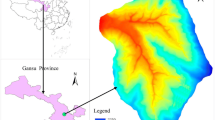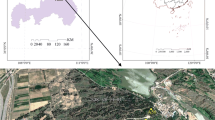Abstract
Soil moisture, a critical variable in the hydrologic cycle, is highly influenced by vegetation restoration type. However, the relationship between spatial variation of soil moisture, vegetation restoration type and slope length is controversial. Therefore, soil moisture across soil layers (0-400 cm depth) was measured before and after the rainy season in severe drought (2015) and normal hydrological year (2016) in three vegetation restoration areas (artificial forestland, natural forestland and grassland), on the hillslopes of the Caijiachuan Catchment in the Loess area, China. The results showed that artificial forestland had the lowest soil moisture and most severe water deficit in 100-200 cm soil layers. Water depletion was higher in artificial and natural forestlands than in natural grassland. Moreover, soil moisture in the shallow soil layers (0-100 cm) under the three vegetation restoration types did not significantly vary with slope length, but a significant increase with slope length was observed in deep soil layers (below 100 cm). In 2015, a severe drought hydrological year, higher water depletion was observed at lower slope positions under three vegetation restoration types due to higher transpiration and evapotranspiration and unlikely recharge from upslope runoff. However, in 2016, a normal hydrological year, there was lower water depletion, even infiltration recharge at lower slope positions, indicating receiving a large amount of water from upslope. Vegetation restoration type, precipitation, slope length and soil depth during a rainy season, in descending order of influence, had significant effects on soil moisture. Generally, natural grassland is more beneficial for vegetation restoration than natural and artificial forestlands, and the results can provide useful information for understanding hydrological processes and improving vegetation restoration practices on the Loess Plateau
Similar content being viewed by others
References
Bi HX, Zhang JJ, Zhu JZ, et al. (2008) Spatial dynamics of soil moisture in a complex terrain in the semi-arid Loess Plateau region, China. Journal of the American Water Resources Association 44:1121–1131. https://doi.org/10.1111/j.1752-1688. 2008.00236.x
Brocca L, Melone F, Moramarco T, et al. (2010) Spatialtemporal variability of soil moisture and its estimation across scales. Water Resources Research 46: W02516. https://doi.org/10.1029/2009WR008016
Chaplot VAM, Le Bissonnais Y (2003) Runoff features for interrill erosion at different rainfall intensities, slope lengths, and gradients in an agricultural loessial hillslope. Soil Science Society of America Journal 67: 844–851.
Chen H, Shao MA, Li YY (2008) Soil desiccation in the Loess Plateau of China. Geoderma 143: 91–100. https://doi.org/10.1016/j.geoderma.2007.10.013
Chen LD, Huang ZL, Gong J, et al. (2007) The effect of land cover/vegetation on soil water dynamic in the hilly area of the loess plateau, China. Catena 70: 200–208. https://doi.org/10. 1016/j.catena.2006.08.007
Cheng LP, Liu WZ (2014) Long term effects of farming system on soil water content and dry soil layer in deep loess profile of loess tableland in china. Journal of Integrative Agriculture 13: 1382–1392. https://doi.org/10.1016/S2095-3119(13)60292-0
Feng Q, Zhao WW, Qiu Y, et al. (2013) Spatial heterogeneity of soil moisture and the scale variability of its influencing factors: A case study in the loess plateau of China. Water 5:1226–1242. https://doi.org/10.3390/w5031226
Fernández-Romero ML, Lozano-García B, Parras-Alcántara L (2014) Topography and land use change effects on the soil organic carbon stock of forest soils in Mediterranean natural areas. Agriculture Ecosystems & Environment 195: 1–9. https://doi.org/10.1016/j.agee.2014.05.015
Fu BJ, Wang J, Chen LD, et al. (2003) The effects of land use on soil moisture variation in the Danangou catchment of the Loess Plateau, China. Catena 54: 197–213. https://doi.org/10.1016/S0341-8162(03)00065-1
Fu XT, Zhang LP (2015) Impact of slope length on red soil erosion under simulated rainfall. Journal of Basic Science and Engineering 23: 474–483(in Chinese).
Gao L, Shao MA (2012) Temporal stability of shallow soil water content for three adjacent transects on a hillslope. Agricultural Water Management 110: 41–54. https://doi.org/10.1016/j.agwat.2012.03.012
Gao XD, Wu P, Zhao XN, et al. (2011) Soil moisture variability along transects over a well-developed gully in the Loess Plateau, China. Catena 87: 357–367. https://doi.org/10.1016/j. catena.2011.07.004
Giraldo MA, Madden M, Bosch D (2009) Land use/land cover and soil type covariation in a heterogeneous landscape for soil moisture studies using point data. GIScience & Remote Sensing 46:77–100.https://doi.org/10.2747/1548-1603.46.1.77
Graham CB, Lin HS (2011) Controls and frequency of preferential flow occurrence: A 175-event analysis. Vadose Zone Journal 10: 816–831. https://doi.org/10.2136/vzj2010. 0119
Gyamfi C, Ndambuki JM, Salim RW (2016) Hydrological Responses to Land Use/Cover Changes in the Olifants Basin, South Africa. Water 8:588. https://doi.org/10.3390/w812 0588
Jackson RB, Canadell J, Ehleringer JR, et al. (1996) A global analysis of root distributions for terrestrial biomes. Oecologia 108:389–411. https://doi.org/10.1007/BF00333714
Jia YH (2013) Spatio-temporal Variability of Soil water Content on a Loessial Slope. PhD thesis, The University of Chinese Academy of Sciences, Shanxi.p135. (In Chinese)
Jia YH, Shao MA (2014) Dynamics of deep soil moisture in response to vegetational restoration on the Loess Plateau of China. Journal of Hydrology 519: 523–531. https://doi.org/10. 1016/j.jhydrol.2014.07.043
Kumagai T, Tateishi M, Shimizu T, et al. (2008) Transpiration and canopy conductance at two slope positions in a Japanese cedar forest watershed. Agricultural and Forest Meteorology 148: 1444–1455. https://doi.org/10.1016/j.agrformet.2008.04. 010
Lin H, Zhou X (2008) Evidence of subsurface preferential flow using soil hydrologic monitoring in the Shale Hills catchment. European Journal of Soil Science 59: 34–49. https://doi. org/10.1111/j.1365-2389.2007.00988.x
Ma L, Teng YG, Shangguan ZP (2014) Ecohydrological responses to secondary natural Populus davidiana and plantation Pinus tabulaeformis woodlands on the Loess Plateau of China. Ecohydrology 7:612–621. https://doi.org/10.1002/eco.1382
Meerveld HJT, McDonnell JJ (2006) On the interrelations between topography, soil depth, soil moisture, transpiration rates and species distribution at the hillslope scale. Advances in Water Resources 29: 293–310. https://doi.org/10.1016/j.advwatres.2005.02.016
Mitchell PJ, Benyon RG, Lane PNJ (2012) Responses of evapotranspiration at different topographic positions and catchment water balance following a pronounced drought in a mixed species eucalypt forest, Australia. Journal of Hydrology 440: 441–62. https://doi.org/10.1016/j.jhydrol.2012.03. 026
Oki T, Kanae S (2006) Global hydrological cycles and world water resources. Science 313:1068–1072. https://doi.org/10.1126/science.1128845
Pan YX, Wang XP, Zhang YF, et al. (2015) Spatio-temporal variability of root zone soil moisture in artificially revegetated and natural ecosystems at an arid desert area, NW China. Ecological Engineering 79: 100–112. https://doi.org/10.1016/j.ecoleng.2015.04.019
Qiu Y, Fu BJ, Wang J, et al. (2001a) Spatial variability of soil moisture content and its relation to environmental indices in a semi-arid gully catchment of the Loess Plateau, China. Journal of Arid Environments 49: 723–750. https://doi.org/10.1006/jare.2001.0828
Qiu Y, Fu BJ, Wang J, et al. (2001b) Soil moisture variation in relation to topography and land use in a hillslope catchment of the Loess Plateau, China. Journal of Hydrology 240: 243–263. https://doi.org/10.1016/S0022-1694(00)00362-0
Seneviratne SI, Corti T, Davin EL, et al. (2010) Investigating soil moisture–climate interactions in a changing climate: A review. Earth-Science Reviews 99: 125–161. https://doi.org/10.1016/j.earscirev.2010.02.004
Sun FX, Lü YH, Wang JL, et al. (2015) Soil moisture dynamics of typical ecosystems in response to precipitation: A monitoring-based analysis of hydrological service in the Qilian Mountains. Catena 129: 63–75. https://doi.org/10.1016/j.catena.2015.03.001
Thomas A (2000) Spatial and temporal characteristics of potential evapotranspiration trends over China. International Journal of Climatology 20: 381–96.
Wang C, Zhao C, Xu ZL, et al. (2013) Effect of vegetation on soil water retention and storage in a semi-arid alpine forest catchment. Journal of Arid Land 5:207–219. https://doi. org/10.1007/s40333-013-0151-5
Wang MB, Li HJ, Chai BF (1996) Effect of extreme rainfall on the soil water cycle of forest land. Journal of Soil Erosion and Soil and Water Conservation 2: 83–92.
Wang XP, Li XR, Xiao HL, et al. (2007) Effects of surface characteristics on infiltration patterns in an arid shrub desert. Hydrological Processes 21: 72–79. https://doi.org/10.1002/hyp.6185
Wang YQ, Shao MA, Liu ZP (2010) Large-scale spatial variability of dried soil layers and related factors across the entire Loess Plateau of China. Geoderma 159: 99–108. https://doi.org/10.1016/j.geoderma.2010.07.001
Wang YQ, Shao MA, Liu ZP, et al. (2012) Regional spatial pattern of deep soil water content and its influencing factors. Hydrological Sciences Journal 57: 265–281. https://doi.org/10.1080/02626667.2011.644243
Wang ZQ, Liu BY, Liu G, et al. (2009). Soil water depletion depth by planted vegetation on the Loess Plateau. Science in China Series D: Earth Sciences 52: 835–842. https://doi.org/10.1007/s11430-009-0087-y
Xiao L, Xue S, Liu GB, et al. (2014) Soil moisture variability under different land uses in the Zhifanggou catchment of the Loess Plateau, China. Arid Land Research and Management 28: 274–290. https://doi.org/10.1080/15324982.2013. 860500
Yang FT, Feng ZM, Wang HM, et al. (2017) Deep soil water extraction helps to drought avoidance but shallow soil water uptake during dry season controls the inter-annual variation in tree growth in four subtropical plantations. Agricultural and Forest Meteorology 234:106–114. https://doi.org/10.1016/j.agrformet.2016.12.020
Yang L, Wei W, Chen LD, et al. (2012) Response of deep soil moisture to land use and afforestation in the semi-arid Loess Plateau, China. Journal of Hydrology 475:111–122. https://doi.org/10.1016/j.jhydrol.2012.09.041
Yang L, Chen LD, Wei W, et al. (2014) Comparison of deep soil moisture in two re-vegetation watersheds in semi-arid regions. Journal of Hydrology 513: 314–321. https://doi.org/10.1016/j.jhydrol.2014.03.049
Yang L, Chen LD, Wei W (2015) Effects of vegetation restoration on the spatial distribution of soil moisture at the hillslope scale in semi-arid regions. Catena 124: 138–146. https://doi. org/10.1016/j.catena.2014.09.014
Yu Y, Wei W, Chen LD, et al. (2015) Responses of vertical soil moisture to rainfall pulses and land uses in a typical loess hilly area, China. Solid Earth 6: 595–608. https://doi.org/10.5194/se-6-595-2015
Yoder CK, Boutton TW, Thurow TL, et al. (1998) Differences in soil water use by annual broomweed and grasses. Journal of Range Management 51: 200–206. https://doi.org/10.2307/4003208
Zhu Q, Nie XF, Zhou XB, et al. (2014) Soil moisture response to rainfall at different topographic positions along a mixed landuse hillslope. Catena 119: 61–70. https://doi.org/10.1016/j. catena.2014.03.010
Acknowledgements
This research was financially supported by the Fundamental Research Funds for the Central Universities (2015ZCQ-SB-03), the National Natural Science Foundation of China (51309007), and the National Key Research and Development Project of China (2016YFC0501704).
Author information
Authors and Affiliations
Corresponding author
Rights and permissions
About this article
Cite this article
Mei, Xm., Ma, L., Zhu, Qk. et al. Responses of soil moisture to vegetation restoration type and slope length on the loess hillslope. J. Mt. Sci. 15, 548–562 (2018). https://doi.org/10.1007/s11629-017-4415-y
Received:
Revised:
Accepted:
Published:
Issue Date:
DOI: https://doi.org/10.1007/s11629-017-4415-y




